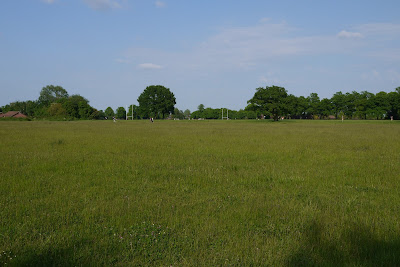Today for 30 Days Wild I had a go at another of my Identiplant assignments, about Fabaceae - the Pea family. I'm fairly familiar with this family as many of its members grow near my office so I thought I should be able to get through it fairly quickly. For the first part of the assignment I had to find three of the four species Medicago lupulina (Black Medick), Trifolium dubium (Lesser Trefoil), Lathyrus pratensis (Meadow Vetchling) and Lotus corniculatus (Bird's-foot Trefoil), and describe their diagnostic features. I think these can all be found near my workplace but I haven't spotted any Meadow Vetchling this year, I don't think it is in flower yet - so I found the other three. For the second part of the assignment I had to find either Vicia sepium (Bush Vetch) or Vicia cracca (Tufted Vetch) and key it out using the Wild Flower Key; I found Vicia cracca.
Diagnostic features of the pea family (generally):
- Usually compound pinnate or trifoliate leaves.
- Unique flower structure: 5 sepals fused into tube, 5 free petals – upper standard, 2 wings on either side enclosing keel formed from 2 lower inner petals. 10 stamens within keel – lower 2/3 of all or sometimes all but one fused into tube surrounding carpel.
Diagnostic features of Medicago lupulina:
- Leaves have mucronate tips and are downy.
- Flowers/fruit-heads stay upright once flowering has finished.
 |
| Black Medick (Medicago lupulina). |
Diagnostic features of Trifolium dubium:
- Leaves have no mucronate tips are are mostly hairless.
- Flowers/fruit-heads droop down once flowering has finished.
 |
| Lesser Trefoil (Trifolium dubium). |
As the previous two species are so similar, the diagnostic features are those which are crucial in telling the two apart. The difference between the flowers/fruit heads wasn't one that was particularly highlighted in the Wild Flower Key but it's one that I noticed in real life - we'll see what my tutor thinks of it. There are other diagnostic characteristics too, to do with fruit structure, but for these assignments I am only supposed to highlight features that I have actually observed - and I didn't find any ripe fruits yet!
Diagnostic features of Lotus corniculatus:
- Yellow flowers with orange/red tinge – red buds.
- Trifoliate leaves but with extra leaf pair at base of stalk.
- Hairless oval leaves.
- Solid stems.
- Sepal points are erect, not reflexed as in L. pedunculatus (another very similar species).
 |
| Bird's-foot Trefoil (Lotus corniculatus). |
I managed to successfully key out Vicia cracca using the Wild Flower Key. I won't post the whole sequence here, here's a pic of the start of the pea family key though - I am getting better at using these having never really got to grips with keys before this course, you can see why it's so important to be familiar with the terminology!
 |
| Start of the pea key! |
 |
| Tufted Vetch (Vicia cracca). |
Then just for fun I also found two more pea family members!
 |
| Grass Vetchling (Lathyrus nissolia). |
 |
| Hop Trefoil (Trifolium campestre). |




























































